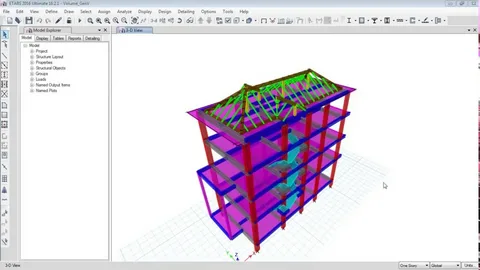Subtotal $0.00
Structural design and analysis are essential for buildings and infrastructure to be efficient, safe, and stable in civil engineering. Structural design procedures are now easier with the use of advanced software by engineers because of advances in technology. ETABS is one of the tools that has been well known and used in the company. A robust software program for building and structural analysis and design, ETABS was created by Computers and Structures, Inc. (CSI). Understanding ETABS will greatly improve your capacity to create safe and effective structures, regardless of your level of experience as a professional or student civil engineer. The main advantages of etabs software for civil engineering projects are examined in this article.
Benefits of ETABS Software
1.Capabilities for Comprehensive Structural Analysis
The extensive structural analysis feature of ETABS is the prime reason that it has been utilised extensively in civil engineering. Using ETABS, engineers can analyse intricate building structures quite comfortably considering a number of variables including gravity, wind, seismic forces, and heat effects. The program guarantees that the structure is stable and safe under different circumstances by calculating the impact of such pressures on buildings and other constructions using intricate algorithms. Engineers can effectively simulate real-life conditions and model the structure with high precision because ETABS is capable of linear and nonlinear static and dynamic analysis. ETABS is a robust and user-friendly interface to conduct complete structural analysis in the process of constructing an industrial building, bridge, or high-rise structure.
2.Structure Optimisation and Optimised Structure Design
Designing is optimised by ETABS, which expedites the process and renders it efficient. Based on the engineer’s input parameters, the software optimises designs and completes structure calculations automatically using its integrated design tools. Beams, columns, slabs, and foundations are just some of the structural elements that ETABS can design according to global design codes and standards. Apart from this, the software provides customers with the option to include unique design parameters, guaranteeing creative freedom with safety and conformity to local laws. Engineers can work on boosting the overall design and maximising the structure’s efficiency by using ETABS to automate the design procedure, which minimises the time and effort needed for manual calculations.
3.Smooth Integration with Other Engineering Software
Civil engineers who are involved in multidisciplinary projects value ETABS as a first-choice tool due to its capacity to work harmoniously with other engineering software and etabs course fees. The software has several file formats that it supports, and data exchange with other building software packages, such as AutoCAD, Revit, SAP2000, etc., is easy. This interface improves workflow productivity by allowing engineers to easily import and export layouts and models across software systems with no loss in data integrity and correctness. This collaborative method, by giving all the parties the most updated design information, enhances coordination while decreasing error probabilities.
4.Easy-to-use Interface and Visualisation Tools
Both inexperienced and experienced engineers are able to use ETABS because it has an easy and easy-to-use interface. With the graphical user interface of the software, models and designs are created graphically by the users, making it simpler to see the behaviour of the structure and identify any flaws at an early stage. The drag-and-drop feature minimises the learning process for new users by making the definition of loads, materials, and boundary conditions simpler. Besides, engineers can also see how buildings react to various conditions of loading through ETABS’s Analysis visualisation tools. Tricky results of the analysis can be easily interpreted because of 3D visualisations, coloured data, and animation options. Engineers can easily communicate difficult technical ideas to customers or stakeholders through the use of this software visualisation by projecting their designs in an interactive format.
5.Advanced Wind Load and Seismic Analysis
One of the primary considerations to remember whilst building structures and structures is how they may react to catastrophic occasions like earthquakes and excessive winds. With its comprehensive seismic and wind pressure evaluation skills, ETABS assists architects in growing structures that are capable of handling these forces. Seismic layout requirements, which might be in keeping with global earthquake-evidence design codes. During construction seismic stressing, ETABS can version and calculate their dynamic behaviour by thinking about location, and constructing peak, in addition to constructing fabric residences. Similarly, ETABS gives equipment for calculating how wind masses affect systems, something very crucial in constructing tall skyscrapers and other homes in windy locations. ETABS makes sure that civil engineers are able to design buildings so that they will be disaster-resistant by making use of these expert analytical competencies.
6.Time and Cost Effectiveness
Time and value efficiencies that ETABS gives in civil engineering projects are likewise a primary benefit. ETABS minimises the risk of errors and guides cumbersome calculations by doing maximum of the layout and evaluation tasks robotically. This enhances the precision of the very last design while, at the same time, accelerating the layout process. ETABS also lets engineers optimise their designs, which lowers production prices and material consumption. Engineers are able to make selections primarily based on facts that can bring about good-sized fee financial savings by way of thinking about numerous design alternatives and assessing their performance in real-time. The fee and time benefits provided by way of ETABS can store mega-projects for an extremely good sum of money both for the duration of the layout level and all through the existence cycle of the undertaking.
Conclusion
For structural analysis and design of civil engineers, ETABS and staad pro class is an absolute requirement. It is a strong tool for design through its full-feature functionality, user-friendly experience, and breakthrough ideas. ETABS increases engineering projects’ workflow and productivity by facilitating engineers in the detailed analysis of structures, optimising elements to be designed, and communicating with other tools. The software is a vital tool in the life of civil engineering professionals since it is capable of performing seismic and wind load calculations, code compliance, and optimising designs to save time and costs. Proficiency in ETABS is vital to establishing a successful career in civil engineering, whether you are an expert designing mega projects or an intern aiming to enhance your proficiency.






